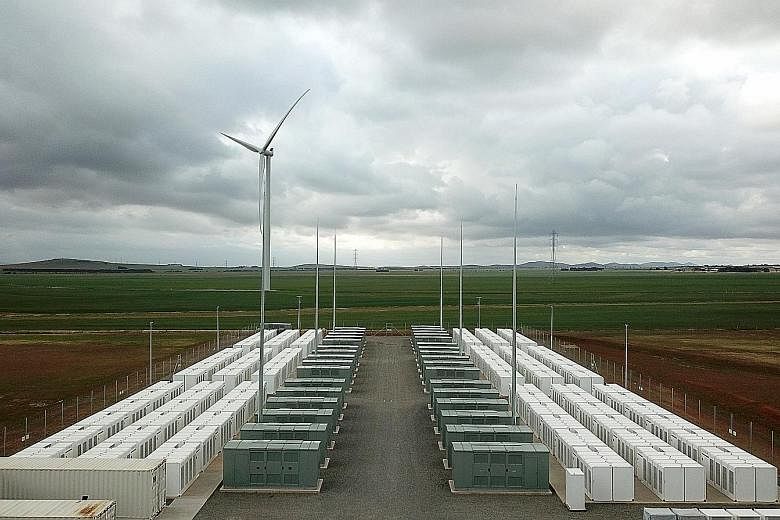Following a severe storm and twin tornadoes on the late afternoon of Sept 28, 2016, the entire state of South Australia - with a population of 1.7 million - suffered a sudden blackout. The so-called "system black" came after the storm damaged high-voltage power lines which led to safety switches being flipped to protect the network.
But the event, which cost businesses an estimated A$367 million (S$364 million), prompted intense debate about the state's energy future. It had already begun a major shift to renewable energy, prompted by high electricity prices and the state's fortuitous abundance of windy plains and sunny days.
Following the blackout, the state continued with its push for renewables but also invited bids to build the world's biggest storage battery as a backup. The contract was won by technology billionaire Elon Musk's company Tesla, which proceeded to construct the world's biggest lithium-ion battery, a 100MW battery farm that can store enough power for more than 30,000 homes.
The battery, which cost about A$90 million and is operated by French firm Neoen, sits alongside its 309MW wind farm that consists of 99 turbines and is the state's largest renewable generator.
Mr Musk's involvement helped to draw global attention to South Australia's remarkable embrace of renewable energy. This clean energy shift is evident from the wind and solar farms scattered across the countryside, as well as the solar panels that sit on houses and buildings in towns and suburbs.
According to the Australian Photovoltaic Institute, more than 30 per cent of dwellings in the state have solar power systems such as rooftop panels. This is the second-highest in the country, just behind Queensland.
-
$364m
-
Estimated cost to businesses as a result of the sudden blackout in 2016, which prompted intense debate about South Australia state's energy future.
Much of the renewables push was led by the previous Labor government, which held power for 16 years until it was defeated by the Liberal Party at a state election in March. The state's new Energy Minister, Mr Dan van Holst Pellekaan, told The Sunday Times that he was committed to boosting its renewable capacity, but also wanted to focus on reliability and reducing electricity prices.
He said he would do this by boosting power storage, interconnection with other state networks, and improving demand management.
"We are determined to continue reducing emissions but instead of pushing electricity prices up, we will show renewable energy can be harnessed properly and push prices down," he said.
"We are very good in South Australia at making electricity from wind and sun. We need to make renewable energy available when consumers need it. We will do that by connecting with another state through household storage."
For now, renewables are likely to continue to grow across the state as investors continue to see benefits - both financial and environmental - from pursuing large-scale wind and solar projects.


